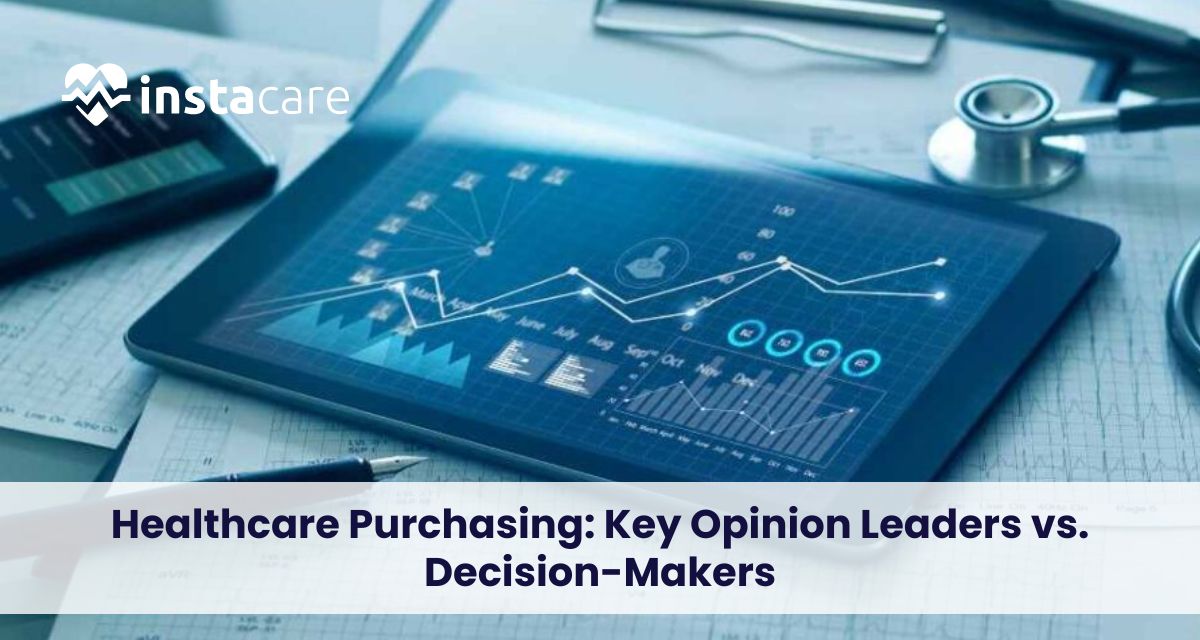Last updated on Thursday, 22, August, 2024
Table of Contents
Healthcare Purchasing: Key Opinion Leaders vs. Decision-Makers
In the often-changing and competitive sphere of healthcare purchasing, it is essential to comprehend the functions of KOL and DM. Both of these groups have vital tasks in influencing purchasing decisions, but they do this in different ways and from different perspectives. This article discusses KOLs and decision-makers in the context of purchasing in the healthcare industry, the bios of these two entities, and the nature and degree of influence they share, as well as the conflicts that exist when their conclusions align in an effort to purchase appropriately for treatment.
What are Key Opinion Leaders (KOLs)?
Definition and Role
KOLs are authorities of their fields, who can be awarded for their scientific achievements, experience, and discoveries in the sphere of medicine. They are usually physicians, researchers or professors of university with good track records whose work are disseminated in research journals, clinical trials, and invited lectures. They enjoy respect from their peers, healthcare providers and even patients hence the making of opinion leaders in the healthcare sector.
Influence on Healthcare Purchasing
KOLs play a likely critical role in HC purchasing decisions, especially with regard to the adoption of new technologies, drugs, or medical devices. This is a big boost for matters regarding their endorsements that can shift the stance of other health care practitioners and institutions. For example, when a KOL gives a good word about the new medical device, doctors or other medical practitioners in the hospitals or clinics will embrace it.
- However, KOLs are more inclined mainly to the clinical utility and evidence-based adage of products.
- It is not the cost, or whether the device is easy to transport or how it fits in the healthcare system that concern them but rather how the new product will enhance the quality of patients’ care or the general practice of medicine in any way.
- This makes their input highly useful especially in cases where the main criteria for assessment are uniqueness or application in the clinical field.
Challenges Faced by KOLs
But then again, KOLs can endorse products and recommend solutions which may not be in harmony with the reality of the budget or procurement procedures now in place. Also, the second and third objectives major on innovation, meaning they might miss the whole picture of adopting a product, like extra training that will be needed, or compatibility with other systems.
An Analysis of Healthcare Purchasing Decision Makers
Definition and Responsibilities
HC Purchasing Decision-Makers are the formal buyers learning decision-making power over HC purchasing either as individuals or in the committees. Such could be the hospital officials, procurement agents, the financial directors, or perhaps a purchasing committee. Their purpose is to compare different options by a set of factors, which comprises the price per item, the quality, compatibility with the rest of the equipment, and the ability to sustain the acquisition.
Influence on Healthcare Purchasing
Deciders are the ultimate authorities in the decision making of a purchase. They do account for the clinical relevance of products, or rather their clinical utility, yet they are far more concerned with costs, standards, and implement ability. As stewards of organizational funds, they must confirm that any purchase is within the organization’s better interest either financially or in the strategies on the ground making KOLs less risky.
- Often, Decision-Makers make their decisions based on the information they are given by KOLs.
- However, others also consider facets like credibility of a supplier, cost attached to the product throughout its usage, and the profit that may well be earned out of the deal.
- This broader point of view makes certain that the last decision made is the right one clinically and fiscally.
Challenges Faced by Decision-Makers
Managers and/or leaders have the dilemma of interfacing between KOL prescriptions and the business facts concerning the company. It has to strike the balance between innovation and cost control, making decisions that can at times be politically sensitive. Also, they bear responsibility for the outcomes of their decisions; it places pressure on the choice made not just in terms of efficiency, but also in terms of where blame resides.
Superimposing the Concepts of KOLs and Decision-Makers
Collaboration and Communication
It can be said that KOLs and Decision-Makers need to work hand in hand most of the time when it comes to successful purchase of healthcare. KOLs present the medical perspective that enables them to evaluate the prospects of new products, while Decision-Makers show the financial and practical approaches to effective purchases. When both these groups of people come together, it is possible to make informed decisions that would be creative, yet would be feasible.
- As in most such relationships, communication is the most important thing in this partnership.
- When communicating with Decision-Makers, KOLs must adapt and present their arguments according to the opinions of such individuals: for instance, persisting on the clinical efficiency of a new technology, although DMs might be more fascinated by the long-term advantages.
Balancing Innovation and Cost
If one is looking at factors influencing healthcare purchasing, then one of the most critical aspects that have to be managed is the tension between innovation and rationalization. Being concerned with clinical results, KOLs can promote the implementation of state-of-the-art solutions that could bring large values to patients. But these are useful and effective often enough because they require more money to be spent at the initial stage and are a concern for Decision-Makers who are to oversee the expenditures of their organizations.
To this end, it is important for KOLs and Decision-Makers to engage in a conversation and consult one another on possible proximate and distant effects of a purchase. For instance, a new technology may be costly in the first instance, but over the course, it may offset the costs through, for example, through patients’ better health, few readmissions or technologies that are easier to maintain.
Issues Present When Attempting to Coordinate KOL and Decisions Maker
Differing Priorities
Among the issues that relate to the main goal of this work and challenge the viewpoints’ compatibility, one of the most important factors is the dissimilarity of the goals that KOLs and Decision-Makers have. Both the KOLs care for clinical utility as well as innovation while the Decision-makers care for cost and implement ability. These discrepancies can, at times, result in contradictions: while a product is recommended and promoted by KOLs, it can be considered expensive or unfeasible by Decision-Makers.
Potential Solutions
To overcome the challenge that separates KOLs and Decision-Makers here follows some of the measures that organizations can adopt. One of them is the better coordination of both groups from the moment of decision-making concerning the perspectives of clinical as well as monetary activity. Also, the implementation of practices promoting the free sharing of information within KOLs and Decision-Makers will enhance the level of trust between the two parties hence improving on the decision making processes.
- Another solution is data and analytics which means that analytical results are used to make decisions.
- By giving end-to- end positive data on cost and genuine advantages of various potential acquisitions, the organizations can better enable KOLs and Decision-Makers to make fair propositions.
Conclusion
Key Opinion Leaders and Decision-Makers in the healthcare purchase both deploy strategic importance but are different entities. By promoting working relations between these two stakeholders, health-care organizations can deal with the challenges of procurement, using the principle of value most creatively to deliver the right results.
FAQs
What role do Key Opinion Leaders (KOLs) play in healthcare purchasing?
KOLs give master clinical experiences, directing choices on new clinical advances or medicines, affecting the reception of imaginative arrangements in medical services associations.
How do Decision-Makers influence healthcare purchasing?
Chiefs assess items in view of cost, functional practicality, and key arrangement, guaranteeing buys are financially reasonable and meet the association’s drawn out objectives.
How can organizations balance the perspectives of KOLs and Decision-Makers?
Associations can adjust these viewpoints by cultivating cooperation, empowering open correspondence, and utilizing information driven experiences to make educated, balanced buying choices.



